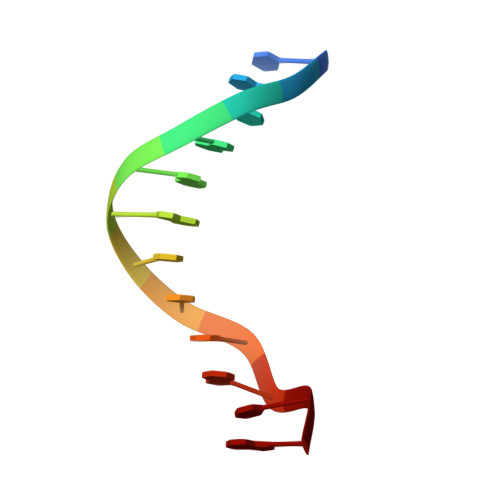Structure of the potassium form of CGCGAATTCGCG: DNA deformation by electrostatic collapse around inorganic cations.
Shui, X., Sines, C.C., McFail-Isom, L., VanDerveer, D., Williams, L.D.(1998) Biochemistry 37: 16877-16887
- PubMed: 9836580
- DOI: https://doi.org/10.1021/bi982063o
- Primary Citation of Related Structures:
428D - PubMed Abstract:
The potassium form of d(CGCGAATTCGCG) solved by X-ray diffraction to 1.75 A resolution indicates that monovalent cations penetrate the primary and secondary layers of the "spine of hydration". Both the sodium [Shui, X., McFail-Isom, L., Hu, G. G., and Williams, L. D. (1998) Biochemistry 37, 8341-8355] and the potassium forms of the dodecamer at high resolution indicate that the original description of the spine, only two layers deep and with full occupancy by water molecules, requires substantive revision. The spine is merely the bottom two layers of a four layer solvent structure. The four layers combine to form a repeating motif of fused hexagons. The top two solvent layers were not apparent from previous medium-resolution diffraction data. We propose that the narrow minor groove and axial curvature of A-tract DNA arise from localization of cations within the minor groove. In general, the results described here support a model in which most or all forces that drive DNA away from canonical B-conformation are extrinsic and arise from interaction of DNA with its environment. Intrinsic forces, originating from direct base-base interactions such as stacking, hydrogen bonding, and steric repulsion among exocyclic groups appear to be insignificant. The time-averaged positions of the ubiquitous inorganic cations that surround DNA are influenced by DNA bases. The distribution of cations depends on sequence. Regions of high and low cation density are generated spontaneously in the solvent region by heterogeneous sequence or even within the grooves of homopolymers. The regions of high and low cation density deform DNA by electrostatic collapse. Thus, the effects of small inorganic cations on DNA structure are similar to the effects of proteins.
Organizational Affiliation:
School of Chemistry & Biochemistry, Georgia Institute of Technology, Atlanta, Georgia 30332-0400, USA.
















